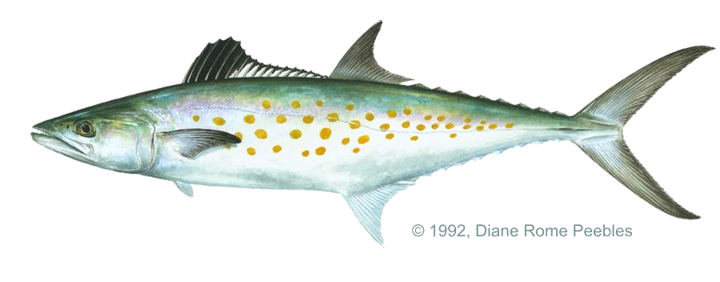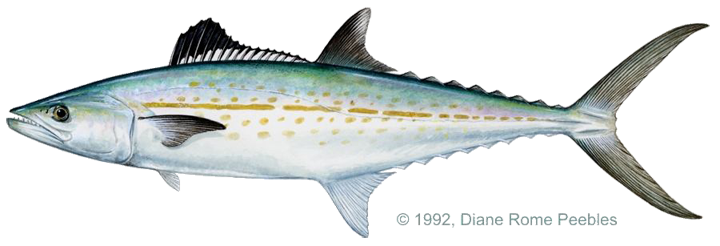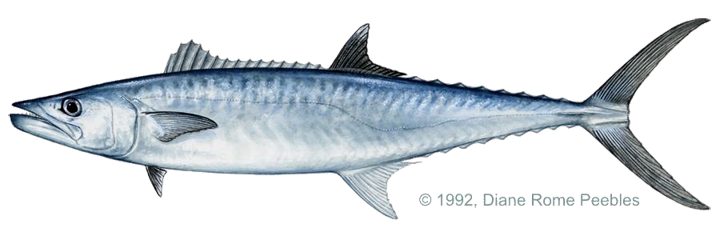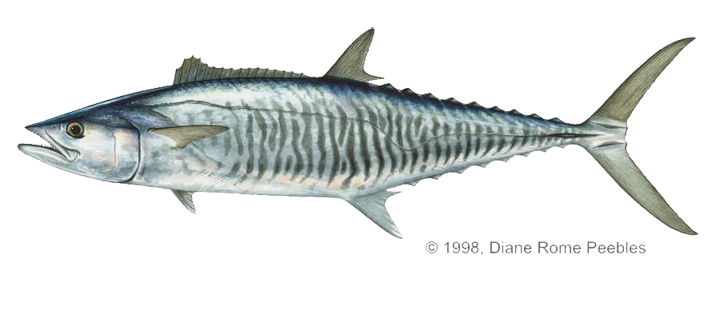Game Fish Identification Reference Guides
Mackerel, Spanish
(Scomberomorus maculatus)
(Scomberomorus maculatus)

(Mitchill, 1815); SCOMBRIDAE FAMILY
Occurs in the western Atlantic north to the Chesapeake Bay and occasionally to Cape Cod, Massachusetts, and south to Yucatan, Mexico.
The Spanish mackerel can be distinguished from both the cero mackerel, Scomberomorus regalis, and the king mackerel, S. cavalla, by the presence of bronze or yellow spots but no stripes, on the sides and by the lack of scales on the pectoral fins. The cero, the Spanish mackerel's closest look alike in the Atlantic, has both spots and stripes of bronze or yellow on the sides, and the king mackerel has neither spots nor stripes. Both the cero and the king mackerel have scales on the pectoral fins.
The anterior portion of the first dorsal fin in the Spanish mackerel is black (not true of the king mackerel), and the second dorsal fin and pectoral fins may be black tipped. The body is essentially silvery and typically mackerel like. The back is bluish.
This is an excellent game fish that can be taken on a wide variety of lures and baits. Nylon jigs are considered one of the best lures, especially when retrieved rapidly with an occasional jerk of the rod tip to impact a darting motion to the jig. Feather lures and spoons are also successful, while minnows and live shrimp are the best natural baits. Occasionally almost any lure or bait will work, while at other times, nothing will.
Spanish mackerel are a good food fish and although they are considered large at 10 lb (4.53 kg) some record specimens will grow to more than twice that size
Occurs in the western Atlantic north to the Chesapeake Bay and occasionally to Cape Cod, Massachusetts, and south to Yucatan, Mexico.
The Spanish mackerel can be distinguished from both the cero mackerel, Scomberomorus regalis, and the king mackerel, S. cavalla, by the presence of bronze or yellow spots but no stripes, on the sides and by the lack of scales on the pectoral fins. The cero, the Spanish mackerel's closest look alike in the Atlantic, has both spots and stripes of bronze or yellow on the sides, and the king mackerel has neither spots nor stripes. Both the cero and the king mackerel have scales on the pectoral fins.
The anterior portion of the first dorsal fin in the Spanish mackerel is black (not true of the king mackerel), and the second dorsal fin and pectoral fins may be black tipped. The body is essentially silvery and typically mackerel like. The back is bluish.
This is an excellent game fish that can be taken on a wide variety of lures and baits. Nylon jigs are considered one of the best lures, especially when retrieved rapidly with an occasional jerk of the rod tip to impact a darting motion to the jig. Feather lures and spoons are also successful, while minnows and live shrimp are the best natural baits. Occasionally almost any lure or bait will work, while at other times, nothing will.
Spanish mackerel are a good food fish and although they are considered large at 10 lb (4.53 kg) some record specimens will grow to more than twice that size
















